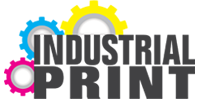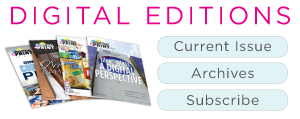
by Cassandra Balentine
Modern digital print technologies support printing directly to a range of objects—including those cylindrical in nature.
Above: A kebab option is available on the Mimaki UJF Series printers to support cylindrical printing.
“As ecommerce and mass customization become more the norm, average run sizes continue to fall, which makes direct-to-object (DTO) printing more appealing,” shares James Bullington, PE CTO, LSINC Corporation. “This is particularly true in markets that have traditionally decorated items using multiple processes. They are finding that tactile effects, textures, and other embellishments can be completed in one print thus eliminating the need for transport and coordination between disparate suppliers.”
Dedicated cylindrical printers and certain desktop flatbed solutions support DTO cylindrical printing.
“The two systems are very different, with the cylindrical printer really being designed for production-level volumes and the capital cost that goes with it. You will likely find the inks designed for specific applications, hence the system may be focused on specific products such as glass bottles or cans,” notes Paul Edwards, VP of the digital division, INX International Ink Co.
Dedicated Cylindrical Printing
One way to print to cylindrical objects is with a dedicated device.
Edwards lists speed as the top advantage of this method. “Depending upon the design of the system, you can get throughput up to around 500 products per minute. However, it is likely that people are more often running at speeds of around 100 to 300 products per minute.”
Another advantage of printing directly to cylindrical objects with a dedicated printer is that it creates a stronger bond to the substrate, as long as the material is compatible, shares Rick Marcelo, technical director, Arcus Printers. “You also get faster print speeds with this method. Some dedicated cylindrical printers even have the ability to print on different surface angles, like a sloped cup instead of just a perfect cylinder.”
Quality is another perk. “The quality of the product can be very good from a color and detail perspective, and the printing finish looks nice and smooth. Depending upon the number of channels in the printer, a range of colors and features are available,” offers Edwards.
Michale Perrelli, director of sales, Innovative Digital Systems (IDS), says direct cylindrical printing offers the ability to print in full color range with special effects and seamless full-wrap design, unlike pad printing, silk screen, label, or offset print solutions.
“Digital print is of course also synonymous with a wide color gamut, and this carries through to DTO digital printing,” shares Jessica Makrinos, marketing manager, Inkcups.
DTO UV inkjet printers typically print with CMYK, white, and varnish, but Makrinos says Inkcups’ Helix range of cylindrical printers have the ability to add light cyan and light magenta. “Additionally, different techniques with varnish, varying ink opacity, or base ink layers make it possible to produce a range of striking special effects that wouldn’t be possible with other printing technologies—from etching and luster to mirror print and stained glass effects.”
Perrelli points out that a dedicated cylindrical printer can efficiently print variable data, allowing for fast and accurate customization processes as well as reduced minimums.
Lon Riley, founder and principal collaborator, DPI Laboratory, says some dedicated cylindrical print machines can have a larger ink throw and more easily accommodate and level obscure shapes, as compared to flatbed rotary systems. They are also fast in one-up printing.
Direct printing eliminates the need for additional production steps, simplifying the workflow, adds Marcelo.
There are limitations to consider. Dedicated cylindrical print machines are still quite expensive and only perform that one rotary action, adds Riley.
Emilio Rangel, UV product manager, Mutoh America, Inc., agrees, noting that these machines are also typically restricted to cylindrical items, making them less adaptable for businesses that need to print on a variety of substrates. “They cannot often accommodate flat or irregularly shaped products, requiring companies to invest in multiple printers to meet diverse printing needs.”
Edwards also sees potential challenges with adhesion, ink laydown quality, and system reliability. “Given the nature of the system, it is not very tolerant to losing nozzles without impacting the image quality. This is where the importance of ink design and system understanding plays a role.”
A substrate may require additional primers to promote adhesion, and in some cases, it may be incompatible, meaning the ink won’t stick, admits Marcelo.
Flatbed Options
In addition to dedicated cylindrical printers, UV flatbed printers with rotary attachments allow for printing onto or around cylindrical objects.
Cost is a consideration. Perrelli notes that flatbeds may be more affordable than a dedicated cylindrical press.
Versatility is also an advantage, as flatbed printers offer the ability to print on a variety of cylindrical objects such as mugs and bottles, without needing a specialized machine. “You can convert back and forth between cylindrical and traditional flatbed goods. You can easily switch between printing on cylindrical objects and flatbed items. A print shop can quickly adjust settings to accommodate different objects or projects, allowing for efficient transitions from one print job to another,” adds Perrelli.
“These devices can print on flat substrates and cylindrical objects, making them ideal multi-purpose investments,” agrees Philip Chu, UV printer product manager, Roland DGA Corporation.
Bullington notes that flatbed printing may have a quality advantage if the media contains a flat surface that deviates from the swept cylinder by more than the jetting distance.
Printing directly to the substrate using a desktop flatbed printer can also result in a strong bond, provided the material is compatible, says Marcelo. “There are no extra production steps required, and you can achieve photo-quality prints with unlimited color options.”
Similar to dedicated presses, Marcelo points out that primers or specific surface preparation may be needed to ensure good adhesion.
Hugo Gonzalez, senior segment specialist, industrial products, Mimaki USA, Inc., points out that printing directly to a cylindrical object on a flatbed printer enables printing more objects at one time, especially using a jig. “In this case, a printer can reasonably print a full table in about the time it would take one or two full wrap prints on a kebab tool.”
Rangel admits there are some limitations primarily with object shapes and sizes. For example, cylindrical objects with handles—like coffee mugs—are unable to run through a rotary due to clearance restrictions. “Despite these limitations, a rotary attachment significantly expands the range of products users can customize.”
Riley agrees, adding that once you level it, the process is repeatable and rotary printing is only one of many functions that flatbeds can perform. “You can make very high-quality rotary prints and still have the benefit of a printer that can customize promotional products, produce signage, and everything else that these machines are designed for.
Marcelo feels the process tends to be slower because the printer only uses a portion of the printhead to maintain a consistent focal length. You also can’t print on surfaces with angles, since any change in focal length results in blurry images. Finally, most desktop flatbeds can only print on one object at a time.”
Scenario Based
Depending on a print provider’s cylindrical printing needs and aspirations, as well as budget, the choice between a dedicated press or flatbed with rotary option might be obvious.
“Some businesses may find that adapting one of their existing flatbeds to have some cylindrical printing capability may be something that works for them in the short term when they are first exploring the possibilities of DTO cylindrical printing,” suggests Makrinos.
Rangel says customers often prefer the versatility of a desktop UV printer with a rotary option due to the range of objects that can be printed on, noting that its flexibility is valuable for businesses that serve diverse markets and need to accommodate various product types.
If quality is essential, Bullington admits that the image quality of a cylindrical printer on cylindrical and pseudo-cylindrical media will always be better by following the curvature for a consistent print gap than what can be achieved on a flatbed where the print gap varies. However, if the media contains a flat surface and it is the only surface to be decorated, a flatbed solution may be simpler to use. “This will depend on the media and how the cure lamps interact with the support fixtures for the media as to how successful one will be.”
A dedicated cylindrical printer is better suited for printing on multi-planed surfaces or objects with angle changes. “These printers are also ideal for larger cylinders with varying depths and profiles. If you’re doing high-volume work, a dedicated cylindrical printer is definitely the way to go,” states Marcelo.
Learning Curves
When moving from an analog process to digital there is a learning curve.
Edwards admits that learning how to utilize the equipment to get the best results on a specific product type can take some time. “There are image design complexities, for example. Some designs are more achievable with a digital system and some less. Since this is a process color system, you need to ensure that the system is correctly profiled to achieve accurate color reproduction.”
Marcelo suggests print providers may go through several test runs and waste parts until the correct measurements are determined. “But once parameters are established for a specific cylinder, you can save that configuration and use it again in the future.”
Specific to dedicated units, Marcelo admits it’s hard to generalize the learning curve because there are so many different printing technologies out there. “With a flatbed printer, the learning curve is relatively simple. You’re just adjusting the artwork size and placement, so there’s no need to conduct image separations.”
One area that requires some knowledge is design. Rangel explains that setting up artwork for a curved surface requires a different approach than designing for a flat print, as users must consider distortion and alignment.
During art development the same traditional techniques of art stretching apply as required for offset and screen printing. “If one wants a logo to look like a circle from the front, the art must be stretched from side to side so one’s eyes perceive it as a circle from the viewer’s perspective. Simple online tutorials can have an artist fully functional upon completion,” explains Bullington.
Riley also feels that some people struggle a bit upfront with visualizing the orientation and placement of art on objects when moving between flat and rotary. “With our Catalyst printers, the rotary is simply an extension of the flatbed so the actual process of embellishing a cylindrical object is exactly the same as printing a flat object. We can also use the same repeatable templates, making it easier for operators to print two, three, or four objects on the rotary at the same time, or call up prior jobs and easily repeat them.”
Rangel says the printing process itself is user friendly given that Mutoh provides detailed instructional videos and implements features in its RIP software, VerteLith, that allow users to output jobs without the need to make many changes on the fly.
When working with a kebab option on the Mimaki UJF Series printers, Gonzalez feels that the learning curve is quite short. Mimaki authorized distributors offer training, and there’s a ten minute video available from Mimaki on installation of the kebab option.
“Understanding the mechanics and the technical applications of the cylindrical printer are the key to shortening the learning curve,” states Perrelli.
IDS’ technical team is dedicated to installing and training customers as well as providing continuous support for its solutions to minimize the learning curve and ensure a smooth and efficient process.
Cylindrical Focus
The potential of digital DTO cylindrical printing is notable. From cans to glassware, these objects are decorated quickly with the added bonus of customization capabilities. For high volumes and odd shapes, a dedicated press has advantages if the economics support it. If you’re looking to add versatility and print to a variety of objects—cylindrical or not—a flatbed press may be the way to go.
Jun2025, Industrial Print Magazine



